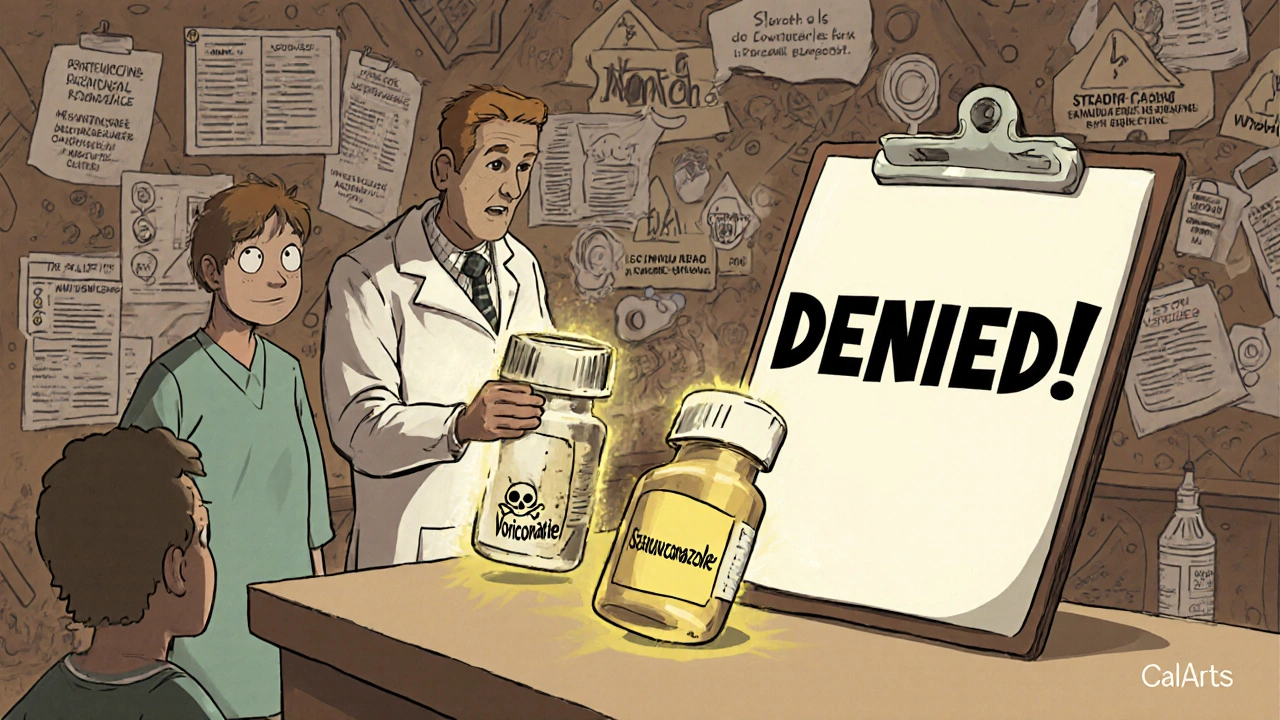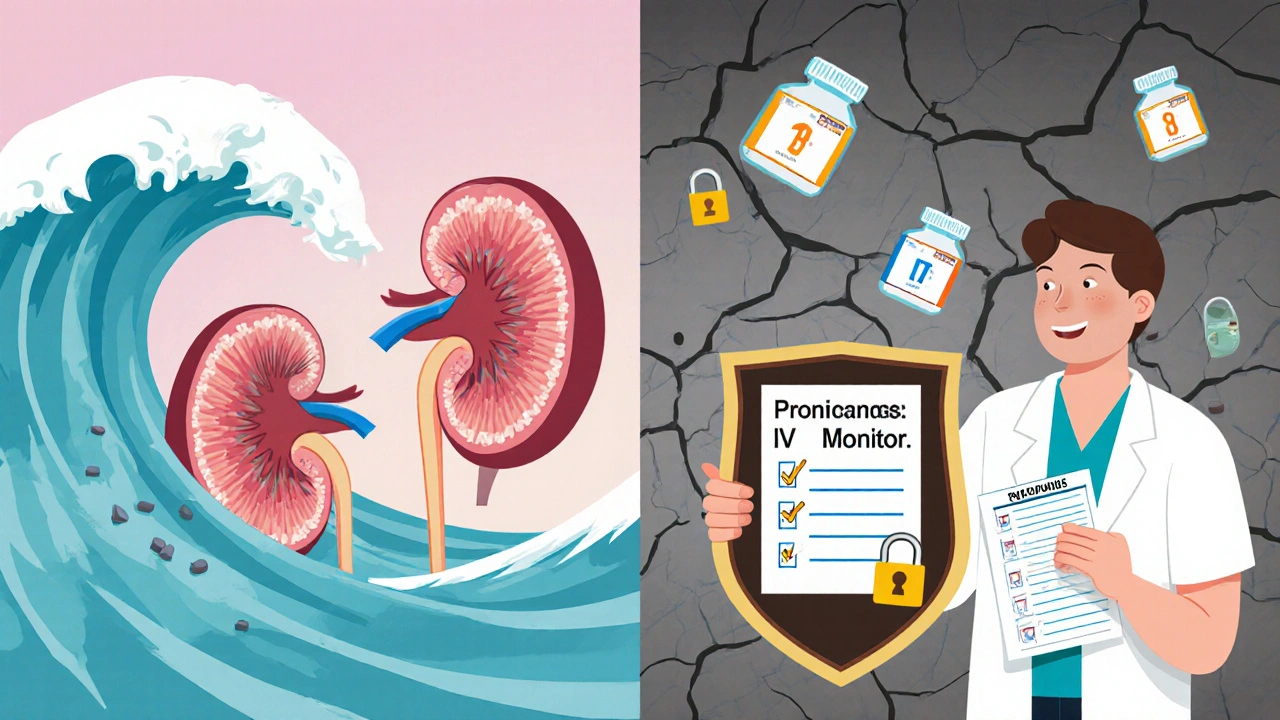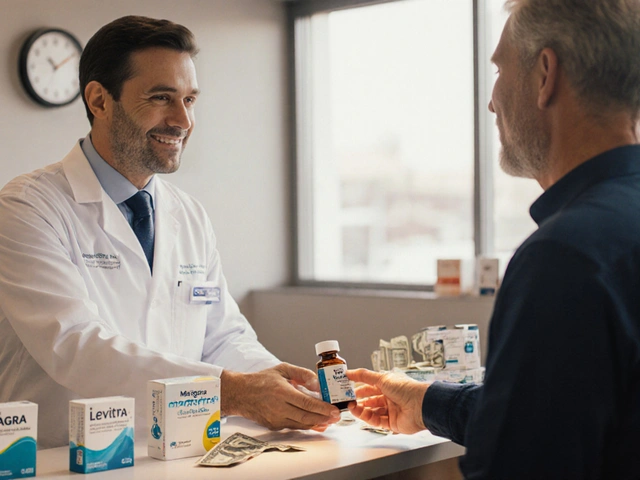Tacrolimus-Azole Dose Adjuster
Adjust Your Tacrolimus Dose
When adding azole antifungals to your treatment, proper dose adjustment is critical to prevent kidney damage and toxicity.
Results
Enter your information above to see dose adjustment recommendations
Monitoring Guidelines
After dose adjustment:
- Check tacrolimus trough levels daily for the first 3-5 days
- Continue monitoring every other day until stable
- Use C/D ratio (concentration/dose) to detect trends earlier
When someone gets a kidney, liver, or lung transplant, they’re given tacrolimus to stop their body from rejecting the new organ. It works. But it’s also a narrow-margin drug-too little and the organ gets rejected; too much and it starts poisoning the kidneys. Now add an antifungal like voriconazole or posaconazole to treat a fungal infection, and things can go sideways-fast. This isn’t theoretical. It happens every week in transplant clinics. And the result? A sudden spike in tacrolimus levels that can send a patient into acute kidney injury within days.
Why Azoles and Tacrolimus Don’t Mix
Tacrolimus is broken down in the liver by an enzyme called CYP3A4. It’s the main way your body clears the drug. Azole antifungals-ketoconazole, itraconazole, voriconazole, posaconazole-shut down that enzyme like flipping a switch. They don’t just slow it down. They block it hard. The result? Tacrolimus doesn’t get cleared. It piles up in the blood. Levels can jump 2 to 10 times higher than normal.It’s not the same with all azoles. Ketoconazole is the strongest inhibitor-so much so that it’s rarely used today for this reason. Voriconazole? It’s common in lung transplant patients and can raise tacrolimus levels by 100-300%. Posaconazole, often used for prevention, still bumps levels up 50-200%. Even isavuconazole, the newer option, still causes a 30-50% increase. That’s why transplant teams don’t just pick antifungals based on what kills fungi-they pick based on what won’t wreck the transplant.
And here’s the kicker: tacrolimus doesn’t just sit in your blood. It builds up in your kidneys. It constricts blood vessels there, reduces blood flow, and damages the tiny filtering units. That’s nephrotoxicity. And when levels spike? That damage happens faster and harder. One study found that 15-20% of all tacrolimus-related kidney injury cases in transplant centers were directly tied to azole interactions.
The Real-World Impact: Patients in the Hospital Overnight
This isn’t a rare side effect you read about in a textbook. It’s a daily clinical emergency.A kidney transplant patient in Ohio went on voriconazole for aspergillosis. His tacrolimus level was 6.5 ng/mL-perfectly safe. Three days later, it was 18.2 ng/mL. His creatinine doubled. He was admitted for acute kidney injury. He spent a week in the hospital. He didn’t die, but his kidney function never fully recovered.
At a lung transplant center in Chicago, pharmacists say they see this exact scenario at least once a week. A patient starts posaconazole for fungal prophylaxis. Two days later, the lab calls: tacrolimus is 15 ng/mL. The patient is dizzy, nauseous, and their creatinine is climbing. They lower the tacrolimus dose by 75%, hold the azole, and monitor hourly. It’s a race against time.
A 2022 survey of 127 transplant pharmacists found that 89% said this interaction was the most common serious drug interaction they managed. And 76% said it led to at least one unplanned hospital admission per month in their unit. These aren’t outliers. They’re the norm.
What Clinicians Do to Stay Ahead
The best defense is a plan-before the azole even starts.Standard protocol in most transplant centers now: when you start a strong CYP3A4 inhibitor like voriconazole or itraconazole, cut the tacrolimus dose by 50-75%. For posaconazole, reduce by 25-50%. For isavuconazole, maybe just 10-20%. You don’t guess. You calculate based on the drug’s known potency.
Then you monitor like crazy. Daily trough levels for the first 3-5 days. Then every other day until stable. Some centers now use the C/D ratio-tacrolimus concentration divided by daily dose-to catch trends earlier than trough levels alone. Studies show this cuts nephrotoxicity by 22%.
Electronic health records now have built-in alerts. If a doctor orders voriconazole for a patient on tacrolimus, the system pops up: “High-risk interaction. Reduce tacrolimus by 70%. Monitor levels daily.” Some centers have automated order sets that lock in the dose reduction and monitoring schedule before the prescription even goes through.
But not every center does this. A 2022 survey by the European Transplant Coordinators Association found that 25-30% of transplant centers still had at least one severe toxicity case per year from this interaction. Why? Because someone forgot. Because the patient was discharged too soon. Because insurance wouldn’t cover the safer azole.

Why Isavuconazole Isn’t Always the Answer
Isavuconazole is weaker on CYP3A4. It’s safer. But it’s also more expensive. Insurance companies often force patients to try voriconazole first-even though it’s riskier. One transplant pharmacist in New York told a colleague: “We had a patient who needed antifungals after a lung transplant. Isavuconazole was the best choice. Insurance denied it. We had to use voriconazole. His tacrolimus spiked to 22 ng/mL. He spent 10 days in the hospital. The cost? $80,000. Isavuconazole would’ve cost $1,200.”That’s the cruel irony. The safer drug is often the harder one to get. And the cost of not using it? Not just money. It’s kidney function. It’s hospital stays. It’s long-term dialysis risk.
Alternatives That Don’t Trigger the Spike
If you need an antifungal and you’re on tacrolimus, you have options that don’t mess with CYP3A4:- Echinocandins: Caspofungin, micafungin, anidulafungin. These are IV-only, but they don’t inhibit CYP3A4. Great for inpatients.
- Lipid-formulation amphotericin B: Still nephrotoxic on its own, but doesn’t raise tacrolimus levels. Used when azoles aren’t an option and fungal infection is life-threatening.
Amphotericin B has its own kidney risk, so you can’t just swap one nephrotoxin for another. But at least you’re not doubling down on the CYP3A4 problem. Some centers now use echinocandins as first-line for suspected invasive fungal infections in transplant patients on tacrolimus-especially if the infection isn’t caused by organisms like Aspergillus, which need azoles.

The Bigger Picture: Why This Matters More Than Ever
Transplant survival rates are better than ever. In the U.S., 97% of kidney transplant recipients are alive one year after surgery. That means more people are living longer on tacrolimus. And longer lives mean more infections-more antifungals needed.Eighty-five percent of lung transplant centers use azole prophylaxis. Seventy percent of liver transplant centers do too. That’s thousands of patients every year getting a drug that can poison their new organ. The 2022 U.S. transplant volume was over 42,000. That’s 42,000 chances for this interaction to happen.
And it’s getting more complex. Newer tacrolimus formulations-like extended-release versions-have smoother blood levels, which might reduce toxicity. Genetic testing is now being used to see if a patient is a CYP3A5 expresser. About half of African Americans and 10-15% of Caucasians have a gene that breaks down tacrolimus faster. That means they might need higher doses, and the interaction with azoles might be less dramatic. But this isn’t routine yet. Only a handful of centers test for it.
What Patients Should Know
If you’re on tacrolimus and your doctor prescribes an antifungal, ask:- Is this azole necessary? Is there a safer alternative?
- Will my tacrolimus dose be lowered? By how much?
- How often will my blood levels be checked?
- What symptoms should I watch for-nausea, tremors, swelling, less urine output?
Don’t assume your doctor knows. This interaction is so common, it’s easy to overlook. But if your levels spike, your kidneys pay the price. And once kidney damage happens, it doesn’t always reverse.
Final Takeaway: It’s Not a Side Effect. It’s a System Failure
This isn’t about bad luck. It’s about systems. When a patient gets an azole without a tacrolimus dose adjustment, it’s not an accident-it’s a breakdown in communication, protocol, or monitoring. The science is clear. The guidelines exist. The tools are available. The question isn’t whether this interaction matters. It’s why we still see preventable cases.Every time a transplant patient ends up in the hospital because their tacrolimus spiked after an antifungal, it’s a reminder: we know how to prevent this. We just have to do it consistently.






Karla Morales
November 22, 2025 AT 13:42Just saw a case like this last month - voriconazole + tacrolimus = kidney crisis in 72 hours. 😰 We had to drop the tacrolimus dose by 80% and switch to micafungin. The patient’s creatinine dropped from 3.8 to 1.4 in 10 days. This isn’t theoretical - it’s Tuesday in transplant ICU. 🚨
Javier Rain
November 23, 2025 AT 13:27YES. This is why we built automated alerts in our EHR. No more ‘oops, forgot to adjust’. If you prescribe voriconazole to someone on tacrolimus, the system auto-lowers the dose, schedules daily levels, and locks out the original order unless you override with a 300-word justification. We cut our toxicity cases by 65% in 18 months. Systems > hope.
Lisa Detanna
November 23, 2025 AT 18:58From a transplant nurse in Chicago - we’ve seen this too many times. I once had a 28-year-old lung transplant patient who got voriconazole for a cough. Three days later, she couldn’t walk to the bathroom. Her tacrolimus was 21. Her creatinine was 4.2. She cried and asked if she’d lose the transplant. We saved her - but she’s on low-dose steroids now, and her GFR is 45. That’s not recovery. That’s damage control. We need better access to safer antifungals. Period.
Demi-Louise Brown
November 24, 2025 AT 03:27Key point: echinocandins are underused. They’re IV only, yes. But for invasive aspergillosis in tacrolimus patients, they’re the gold standard if the patient can tolerate IV therapy. No CYP3A4 inhibition. No spike. Just antifungal power. Why aren’t we starting here more often?
Matthew Mahar
November 24, 2025 AT 10:59ok so like… i just had my cousin’s husband get a liver transplant and they gave him fluconazole for a yeast infection and he went into kidney failure?? and the docs were like ‘oh yeah that’s normal’?? like??? no??? this should NOT be normal??
John Mackaill
November 26, 2025 AT 02:24Interesting how the UK handles this differently - we rarely use voriconazole as first-line in transplant patients. Liposomal amphotericin or caspofungin are preferred unless there’s a clear indication for azoles. We also have mandatory pharmacist-led pre-emptive dose reductions. It’s not perfect, but our tacrolimus toxicity rate is half of what it is in the US. Culture matters.
Adrian Rios
November 26, 2025 AT 06:56Let’s be real - this isn’t just about drug interactions. It’s about systemic neglect. We have the tools. We have the data. We have the guidelines. But we still rely on individual pharmacists to catch these errors because the system doesn’t enforce safety. It just hopes someone remembers. And when they don’t? A patient loses a kidney. A family loses peace. A system loses credibility. We’ve known this for 15 years. Why are we still playing Russian roulette with immunosuppressants?
Casper van Hoof
November 26, 2025 AT 20:53One might argue that this interaction exemplifies the epistemological fragility of modern pharmacotherapy: we optimize for efficacy while simultaneously ignoring the entangled, nonlinear dynamics of polypharmacy. The body is not a machine with isolated levers. It is a symphony - and when one instrument is muted, the entire composition collapses. Azoles do not merely inhibit CYP3A4 - they disrupt the delicate equilibrium of survival.
Richard Wöhrl
November 28, 2025 AT 02:53Wait - did anyone mention genetic testing for CYP3A5? About 50% of Black patients are rapid metabolizers - they need higher tacrolimus doses, so the azole interaction might be less severe. But we don’t test routinely. We assume everyone’s the same. That’s dangerous. One center in Atlanta started routine genotyping and saw a 40% drop in toxicity events. Why isn’t this standard? Because it’s cheaper to treat the crisis than prevent it.
Pramod Kumar
November 28, 2025 AT 07:34Bro, in India we barely have access to tacrolimus, let alone isavuconazole. But when we do - we use it like gold. I once had a patient who got micafungin after a transplant, and his doc said, ‘We can’t afford the fancy stuff.’ I said, ‘Then don’t give him the killer antifungal.’ He’s alive today. Sometimes the safest drug is the one you don’t give. Simple. Brutal. True.